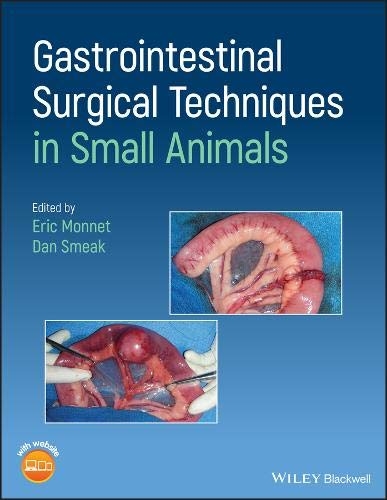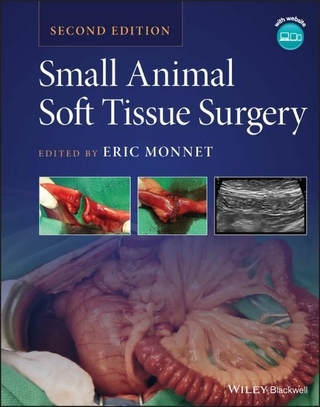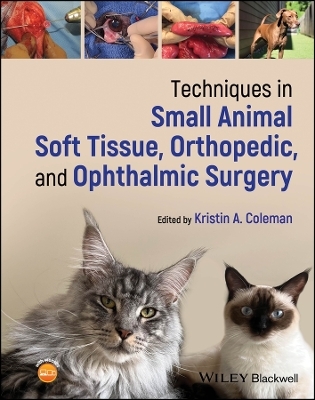
Gastrointestinal Surgical Techniques in Small Animals
Wiley-Blackwell (Verlag)
978-1-119-36920-2 (ISBN)
Logically divided into sections by anatomy, each chapter covers indications, contraindications, and decision making for a specific surgery. Tips and tricks and potential complications are also covered.
- Describes techniques for canine and feline gastrointestinal surgery in detail
- Presents the state of the art for GI surgery in dogs and cats
- Includes access to a companion website with video clips demonstrating techniques
»Gastrointestinal Surgical Techniques in Small Animals« is an essential resource for small animal surgeons and veterinary residents.
Eric Monnet, DVM, PhD, FAHA, Diplomate ACVS, ECVS, is a Professor in the Department of Clinical Sciences at Colorado State University in Fort Collins, Colorado, USA.
Dan Smeak, DVM, Diplomate ACVS, is a Professor in the Department of Clinical Sciences at Colorado State University in Fort Collins, Colorado, USA.
List of Contributors
Preface
About the Website
Section I: General concepts
Chapter 1: Intestinal healing
Eric Monnet and Daniel Smeak
Anatomy
Phases of wound healing
Factors affecting gastrointestinal tract healing
Chapter 2: Suture materials, staplers, and tissue apposition devices
Daniel Smeak
Suture materials
Predictable absorption profile
Tensile strength and knot security
Low capillarity and bacterial adhesion
Handling characteristics
Rate of strength gain in GI surgery
Suture needles
Directional barbed suture
Biofragmentable anastomosis ring
Staplers, Linear, Circular, Skin staplers
Chapter 3: Suture pattern
Daniel Smeak
One or two layer closure
Tissue inversion eversion or apposition
Stapled or hand-sutured anastomosis
Apposition suture patterns
Simple interrupted
Simple continuous
Patterns to reduce excessive mucosal eversion
Inverting suture patterns
Halstead
Cushing and Connell
Lembert
Parker Kerr oversew
Special supplementary patterns: Purse-string
Chapter 4: Feeding tubes
Eric Monnet
Nasoesophageal and nasogastric tubes
Indications
Materials and equipment
Surgical techniques
Utilization
Tips
Complications
Esophagostomy tube
Indications
Materials and equipment
Surgical techniques
Utilization
Tips
Complications
Gastrostomy tube
Indications
Materials and equipment
Surgical techniques
Endoscopic placement
Laparoscopically assisted
Laparotomy
Utilization
Tips
Complications
Jejunostomy tube
Indications
Materials and equipment
Surgical techniques
Laparoscopically assisted
Laparotomy
Utilization
Tips
Complications
Gastro-Jejunostomy tube
Indications
Materials and equipment
Surgical techniques
Utilization
Tips
Complications
Chapter 5: Drainage technique
Eric Monnet
Indications
Techniques
Percutaneous placement of an abdominal drain
Passive drain
Closed suction drain
Surgical placement of a closed suction drain
Open abdomen
Vacuum assisted drainage of the abdominal cavity
Tips
Complications and after care
Section II: Oral cavity
Chapter 6: Mandibulectomy and maxillectomy
Bernard Seguin
Indications
Surgical techniques
Maxillectomy
Mandibulectomy
Tips
Complications and postoperative care
Complications of maxillectomy
Complications of mandibulectomy
Chapter 7: Glossectomy
Eric Monnet and Bernard Seguin
Indications
Surgical techniques
Tips
Complications and prognosis
Chapter 8: Tonsillectomy
Eric Monnet and Bernard Seguin
Indications
Surgical techniques
Tips
Complications and prognosis
Chapter 9: Palate defect
Chad Lothamer and Jennifer Rawlinson
Indications
Surgical techniques
Repair of congenital cleft palate correction techniques
Secondary cleft palate correction techniques
Von Langenbeck technique
Overlapping flap technique
Soft palate repair techniques
Bilateral medially positioned flaps
Overlapping flap technique for repair of the soft palate
Repair of acquired defects
Vestibular mucoperiosteal flaps
Palatal mucoperiosteal flaps
Transposition flap
Split palatal U-flap
Rotating palatal island flap
Palatal advancement flaps
Miscellaneous palatal repair and salvage techniques
Midline palatal fracture or separation
Myoperitoneal microvascular free flap
Angularis Oris mucosal flap
Obturators
Bone and cartilage grafts for the support of pedicle grafts
Tips
Complications
Chapter 10: Salivary glands surgery
Daniel Smeak
Indications
Surgical techniques
Anatomical considerations
Removal of sialoliths
Cervical, pharyngeal, rankle mucocele
Approaches to the mandibular/sublingual salivary complex
Ventral Approach
Marsupialization of Pharyngeal Mucoceles and Ranulas
Zygomatic salivary mucocele
Surgical exposure (approaches) for zygomatic sialadenectomy
Gland Excision Technique
Parotid mucocele
Tips
Complications and outcome
Section III: Esophagus
Chapter 11: Esophagotomy
Eric Monnet
Indications
Surgical techniques
Surgical approach to the esophagus
Esophagotomy
Patch
Tips
Complications
Chapter 12: Esophagectomy
Eric Monnet
Indications
Surgical techniques
Esophagectomy
Dilation and diverticulum of the esophagus
Substitution
Tips
Complications
Chapter 13: Cricopharyngeal myectomy and Heller myectomy
Eric Monnet
Indications
Surgical techniques
Cricopharyngeal myotomy
Heller's myotomy
Tips
Cricopharyngeal myotomy
Heller's myotomy
Complications
Chapter 14: Vascular ring anomalies
Eric Monnet
Indications
Surgical techniques
Intercostal thoracotomy
Ligamentum arteriosum
Double aortic arch
Thoracoscopy
Tips
Complications and aftercare
Chapter 15: Hiatal hernia
Eric Monnet
Indications
Surgical techniques
Laparotomy
Laparoscopy
Tips
Complications and post-operative cares
Section IV: Stomach
Chapter 16: Anatomy and physiology of the stomach
Eric Monnet
Anatomy
Divisions
Morphology and glandular organization
Blood supply
Innervation
Physiology
Gastrin
Somatostatin
Histamine
Ghrelin and leptin
Other gastric secretory products
Acid secretion
Acid secretions and gastrectomy
Stomach motility and gastrectomy
Chapter 17: Gastrotomy
Eric Monnet
Indications
Surgical techniques
Tips
Complications and post-operative cares
Chapter 18: Gastrectomy
Eric Monnet
Indications
Surgical techniques
Local gastrectomy for resection of neoplasia or ulcer
Local gastrectomy for resection of GDV
Segmental gastrectomy
Tips
Complications and post-operative cares
Chapter 19: Billroth I
Eric Monnet
Indications
Surgical techniques
Tips
Complications
Chapter 20: Billroth II
Eric Monnet
Indications
Surgical techniques
Gastrectomy
Dissection of the duodenum
Gastro-jejunostomy
Cholecystoduodenostomy
Feeding tubes
Tips
Complications and post-operative cares
Dumping syndrome
Afferent loop syndrome
Gastritis and esophagitis
Chapter 21: Pyloroplasty
Eric Monnet
Indications
Surgical techniques
Y-U pyloroplasty
Other pyloroplasty
Pyloromyotomy
Tips
Complications
Chapter 22: Roux in Y
Eric Monnet
Indications
Surgical techniques
Roux in Y for upper GI reconstruction
Roux in Y for biliary diversion
Roux in Y for upper GI diversion
Tips
Complications and post-operative cares
Chapter 23: Gastropexy
Daniel Smeak
Indications
Surgical techniques
Tube gastropexy
Incisional gastropexy
Belt loop gastropexy
Circumcostal gastropexy
Gastrocolopexy
Incorporating gastropexy
Endoscopically assisted gastropexy
Laparoscopic assisted gastropexy
Laparoscopic gastropexy
Tips
Complications and complications
Section V: Intestine
Chapter 24: Enterotomy
Daniel Smeak
Indications
Surgical techniques
Intestinal biopsy
Enterotomy
Tips
Leak test
Reinforcement of an enterotomy
Complications and outcome
Chapter 25: Enterectomy
Daniel Smeak
Indications
Surgical techniques
Hand sewn anastomosis
Anastomosis using skin stapler
Functional end to end anastomosis with stapling equipment: open technique
One stage functional end to end anastomosis
Tips
Anatomical considerations
Handling of tissue
Utilization of linear stapler
Suture line reinforcement
Complications and outcome
Chapter 26: Enteroplication
Daniel Smeak
Indications
Surgical techniques
Complete enteroplication
Limited enteroplication
Tips
Anatomical considerations
Handling of tissue
Utilization of linear stapler
Suture line reinforcement
Complications and outcome
Section VI: Colon
Chapter 27: Colectomy
Daniel Smeak and Eric Monnet
Indications
Surgical techniques
Preoperative considerations
Surgical procedures
Colonic anastomosis closure methods
Surgical techniques
Tips
Postoperative considerations and prognosis
Chapter 28: Colotomy
Daniel Smeak
Indications
Surgical techniques
Preoperative considerations
Surgical procedure
Tips
Postoperative considerations and prognosis
Chapter 29: Thyplectomy
Daniel Smeak
Indications
Surgical techniques
Simple typhlectomy
Colotomy and typhlectomy
Ileocolic resection and anastomosis
Tips
Postoperative considerations and prognosis
Chapter 30: Colostomy
Daniel Smeak
Indications
Surgical techniques
Flank diverting loop rod-supported colostomy
End on colostomy
Laparoscopic assisted end-on jejunostomy
Tips
Postoperative considerations and prognosis
Chapter 31 Colopexy
Daniel Smeak
Indications
Surgical techniques
Standard ventral midline approach
Paramedian incorporating
Laparoscopic colopexy
Laparoscopic assisted colopexy
Tips
Postoperative care and complications
Section VII: Rectum and anal sac
Chapter 32: Approaches to the rectum
Daniel Smeak
Indications
Surgical approaches to the rectum
Dorsal approach
Lateral approach
Ventral approach with pubic osteotomy
Postoperative care and complications
Chapter 33: Surgery of the rectum
Daniel Smeak
Indications
Surgical techniques
Transanal technique
Combined transanal and abdominal techniques
Tips
Postoperative care and complications
Chapter 34: Anal sac resection
Daniel Smeak
Indications
Surgical techniques
Preparation and positioning of the patient
Open techniques
Closed techniques
Closed techniques for anal sac neoplasia
Tips
Postoperative care and complications
Section IV: Liver and gall bladder
Chapter 35: Liver lobectomy
Eric Monnet
Indications
Surgical techniques
Liver biopsy
Laparotomy
Laparoscopy
Partial liver lobectomy
Complete liver lobectomy
Liver lobectomy with sutures
Liver lobectomy with staples
Tips
Complications
Chapter 36: Surgery of the gall bladder
Eric Monnet
Indications
Surgical techniques
Cholecystostomy
Cholecystotomy
Cholecystectomy
Laparotomy
Laparoscopy
Tips
Complications and postoperative care
Chapter 37: Biliary diversion
Eric Monnet
Indications
Surgical techniques
Temporary bile diversion
Temporary cholecystostomy tube during laparotomy
Temporary cholecystostomy tube with laparoscopy
Permanent biliary diversion
Cholecystoduodenostomy
Roux in Y diversion
Cholecystojejunostomy
Choledochoduodenostomy or choledochojejunostomy
Tips
Complications
Chapter 38: Surgery of the bile duct
Eric Monnet
Indications
Surgical techniques
Choledochotomy
Resection anastomosis of the common bile duct
Choledochoduodenostomy or choledochojejunostomy
Complications
Chapter 39: Biliary stenting
Eric Monnet
Indications
Surgical techniques
Short term temporary stenting
Long term temporary stenting
Permanent stenting
Tips
Complications and post-operative cares
Chapter 40: Arterio-venous fistula
Eric Monnet
Indications
Surgical techniques
Laparotomy
Interventional radiology
Tips
Complications
Chapter 41: Portosystemic shunts
Eric Monnet
Indications
Surgical techniques
Extraheaptic shunt
Identification
Dissection
Intraheaptic shunt
Identification
Dissection
Techniques for ligation or progressive occlusion of the shunt
Techniques resulting in fixed attenuation of a shunt
Techniques resulting in slow progressive and complete occlusion of a shunt
Tips
Complications
Post-operative complications and short term outcome
Long term complications and outcome
Section V: Pancreas
Chapter 42: Surgery of the pancreas
Daniel Smeak
Indications
Surgical procedures
Pancreatic biopsy
Nodulectomy
Partial pancreatectomy
Total pancreatectomy
Pancreatic drainage
Tips
Post-operative care and complications
| Erscheinungsdatum | 15.06.2020 |
|---|---|
| Verlagsort | Hoboken |
| Sprache | englisch |
| Gewicht | 666 g |
| Einbandart | gebunden |
| Themenwelt | Veterinärmedizin ► Kleintier ► Chirurgie |
| Schlagworte | Chirurgie (Veterinärmedizin) • Kleintiere; Veterinärmedizin |
| ISBN-10 | 1-119-36920-7 / 1119369207 |
| ISBN-13 | 978-1-119-36920-2 / 9781119369202 |
| Zustand | Neuware |
| Haben Sie eine Frage zum Produkt? |
aus dem Bereich


